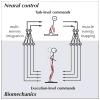Neuromechanics of muscle synergies for posture and movement
- PMID: 18304801
- PMCID: PMC4350235
- DOI: 10.1016/j.conb.2008.01.002
Neuromechanics of muscle synergies for posture and movement
Abstract
Recent research suggests that the nervous system controls muscles by activating flexible combinations of muscle synergies to produce a wide repertoire of movements. Muscle synergies are like building blocks, defining characteristic patterns of activation across multiple muscles that may be unique to each individual, but perform similar functions. The identification of muscle synergies has strong implications for the organization and structure of the nervous system, providing a mechanism by which task-level motor intentions are translated into detailed, low-level muscle activation patterns. Understanding the complex interplay between neural circuits and biomechanics that give rise to muscle synergies will be crucial to advancing our understanding of neural control mechanisms for movement.
Figures


Similar articles
-
Control of voluntary trunk movements in man. Mechanisms for postural equilibrium during standing.Acta Physiol Scand Suppl. 1990;595:1-60. Acta Physiol Scand Suppl. 1990. PMID: 2080712 Review.
-
Optimization of muscle activity for task-level goals predicts complex changes in limb forces across biomechanical contexts.PLoS Comput Biol. 2012;8(4):e1002465. doi: 10.1371/journal.pcbi.1002465. Epub 2012 Apr 12. PLoS Comput Biol. 2012. PMID: 22511857 Free PMC article.
-
Control of fast-reaching movements by muscle synergy combinations.J Neurosci. 2006 Jul 26;26(30):7791-810. doi: 10.1523/JNEUROSCI.0830-06.2006. J Neurosci. 2006. PMID: 16870725 Free PMC article. Clinical Trial.
-
A limited set of muscle synergies for force control during a postural task.J Neurophysiol. 2005 Jan;93(1):609-13. doi: 10.1152/jn.00681.2004. Epub 2004 Sep 1. J Neurophysiol. 2005. PMID: 15342720
-
[From posture to initiation of movement].Rev Neurol (Paris). 1990;146(10):536-42. Rev Neurol (Paris). 1990. PMID: 2263815 Review. French.
Cited by
-
Beta- and gamma-range human lower limb corticomuscular coherence.Front Hum Neurosci. 2012 Sep 11;6:258. doi: 10.3389/fnhum.2012.00258. eCollection 2012. Front Hum Neurosci. 2012. PMID: 22973219 Free PMC article.
-
Adaptive Adjustments in Lower Limb Muscle Coordination during Single-Leg Landing Tasks in Latin Dancers.Biomimetics (Basel). 2024 Aug 13;9(8):489. doi: 10.3390/biomimetics9080489. Biomimetics (Basel). 2024. PMID: 39194468 Free PMC article.
-
The body-machine interface: a new perspective on an old theme.J Mot Behav. 2012;44(6):419-33. doi: 10.1080/00222895.2012.700968. J Mot Behav. 2012. PMID: 23237465 Free PMC article. Review.
-
Common Motor Drive Triggers Response of Prime Movers When Two Fingers Simultaneously Respond to a Cue.Brain Sci. 2021 May 26;11(6):700. doi: 10.3390/brainsci11060700. Brain Sci. 2021. PMID: 34073345 Free PMC article.
-
"Fine synergies" describe motor adaptation in people with drop foot in a way that supplements traditional "coarse synergies".Front Sports Act Living. 2023 Feb 17;5:1080170. doi: 10.3389/fspor.2023.1080170. eCollection 2023. Front Sports Act Living. 2023. PMID: 36873662 Free PMC article.
References
-
- Klein Breteler MD, Simura KJ, Flanders M. Timing of muscle activation in a hand movement sequence. Cereb Cortex. 2007;17:803–815. - PubMed
-
- Tresch MC, Saltiel P, Bizzi E. The construction of movement by the spinal cord. Nat Neurosci. 1999;2:162–167. - PubMed
-
- Torres-Oviedo G, Ting LH. Muscle synergies characterizing human postural responses. J Neurophysiol. 2007 In human postural responses, trial-by-trial variations in muscle activation patterns previously associated with adaptation and habituation were accounted for by variations in muscle synergy activation levels across trials. This suggests that descending cognitive and adaptive influences alter postural strategies through the selection and coordination of muscle synergies. - PubMed
-
- Torres-Oviedo G, Macpherson JM, Ting LH. Muscle synergy organization is robust across a variety of postural perturbations. J Neurophysiol. 2006;96:1530–1546. Muscle synergies for postural control were found to produce consistent endpoint force vectors in a limb-referenced coordinate system. These synergies were robustly used in postural configurations that altered the biomechanical contributions of each muscle synergy to postural stabilization, as well as across different perturbations that dramatically altered sensory information eliciting muscle synergy activation. - PubMed
-
- d’Avella A, Portone A, Fernandez L, Lacquaniti F. Control of Fast-Reaching Movements by Muscle Synergy Combinations. J Neurosci. 2006;26:7791–7810. The authors identify time-varying muscle synergy patterns during reaching movements in humans. They contrast their time-varying muscle synergy formulation with the “static” formulation used by other researchers [2–4] to demonstrate that their formulation may provide a more compact representation in the nervous system. - PMC - PubMed
Publication types
MeSH terms
Grants and funding
LinkOut - more resources
Full Text Sources
Other Literature Sources
Medical

